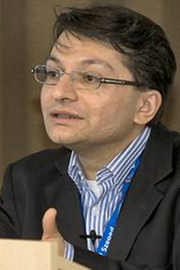
Current Research
Over the past five years, research in Dr. Parekh’s lab has focused on four main themes:
To address these issues, the Lab uses a combination of patch clamp electrophysiology (to measure ion movement through CRAC channels directly), fluorescence imaging of cytoplasmic Ca2+ concentration, confocal microscopy, molecular biology, biochemistry and functional assays including electrical capacitance measurements to monitor exocytosis in single cells and enzyme immuno-assay for detecting secreted paracrine signals like leukotriene C4.
Calcium Signalling and Cell Function
Animal cells are often stimulated by a rise in intracellular calcium (Ca2+) concentration. One major way to increase intracellular Ca2+ is through opening of Ca2+-selective channel pores in the cell surface. A key Ca2+ channel pore is the store-operated channel which is necessary for stimulating a diverse array of cellular responses. Abnormalities in store-operated channel function have been linked to a variety of human disorders including primary immuno-deficiencies, inflammation and possibly Alzheimer’s disease. Understanding how store-operated channels work may therefore result in new therapies for treating these disorders.
An increase in cytoplasmic Ca2+ concentration is used as a key signalling messenger in virtually every cell through the phylogenetic tree, where it regulates a broad spectrum of kinetically distinct processes. Intracellular Ca2+ is often considered a “life-giving” signal because it is essential both for sperm motility and the acrosome reaction and, in the form of periodic Ca2+ oscillations, for fertilization of the egg. Ca2+ is also vital for sustaining the life of the organism. Distinct spatial and temporal patterns of cytoplasmic Ca2+ increases drive processes as diverse as exocytosis, gene transcription and cell motility. Having given life, Ca2+ can also take it away. This dark side of the Ca2+ signal can be executed through apoptosis or the more destructive and less specific necrosis.
Eucaryotic cells can increase their cytoplasmic Ca2+ concentration in one of two ways: release from intracellular stores or Ca2+ influx into the cell. The Ca2+ release phase is transient sometimes fully deactivating within a few tens of seconds. However, many key processes require sustained increases in intracellular Ca2+ and this is accomplished through Ca2+ entry into the cell.
A variety of different Ca2+-permeable channels have been found to co-exist in the plasma membrane. In electrically non-excitable cells, which include the cells of the immune system, endothelia, epithelia and glia, the major Ca2+ influx pathway is the store-operated one, in which emptying of the intracellular inositol trisphosphate (InsP3)-sensitive Ca2+ stores results in the opening of store-operated Ca2+ channels in the plasma membrane. Although a family of store-operated channels is thought to exist, the best characterised and most widely distributed member is the Ca2+-release activated Ca2+ (CRAC) channel.
It has now been established that Ca2+ entry flowing through CRAC channels (called CRAC current or ICRAC) is essential for the normal functioning of non-excitable cells. Abnormalities in ICRAC have been linked to debilitating diseases like certain primary immuno-deficiencies, acute pancreatitis and possibly Alzheimer’s disease. Therefore understanding the molecular mechanisms that control CRAC channels may lead to the design of novel therapeutic agents aimed at treating these human disorders.
Content source: http://www.dpag.ox.ac.uk/academic_staff/anant_parekh/parekh_research